Gloucester Cathedral’s cloisters are famous for being filmed as the halls of Hogwarts in Harry Potter, but this church is filled with even more history and beauty than the movies show. Walking through those stone corridors, I honestly felt like I’d stepped into another world—one shaped by centuries of monks, kings, and artists.
At every turn, echoes of the past mixed with little sparks of magic from the big screen. It’s hard not to get swept up in it.
There’s so much more to Gloucester Cathedral than its film fame. The carvings, stained glass, and quiet corners whisper stories of worship, community, and daily life going back nearly a thousand years.

My visit was this wild blend of Harry Potter magic and real English history, all under one soaring roof.
The Magnificence of Gloucester Cathedral
Gloucester Cathedral—officially, the Cathedral Church of St Peter and the Holy and Indivisible Trinity—shows off centuries of English religious and architectural history. The design shifts from massive Norman foundations to those dramatic Gothic arches, and finally to some of the best examples of perpendicular architecture in the country.
Origins and Architectural Evolution
When I wander through Gloucester Cathedral, it’s impossible not to feel the weight of its history. The original church dates all the way back to 678 or 679 AD, though most of what stands today rose after the Norman Conquest.
The Normans kicked off a rebuild around 1089, adding that grand nave and crypt. Through the 12th and 13th centuries, new chapels and a larger choir popped up as Gloucester’s importance grew.
The cathedral kept expanding, always adapting to new styles and needs. It became a center for pilgrims, especially after King Edward II was buried here in 1327. That drew visitors for centuries.
Norman and Gothic Design Elements
Thick stone walls and rounded arches in the nave and crypt still show off those sturdy Norman features. Later Gothic upgrades brought pointed arches and bigger windows, softening the feel.
The Gothic transformation really shines in the choir and east end. Slender columns and ribbed vaulting stretch upward, pulling in more light.
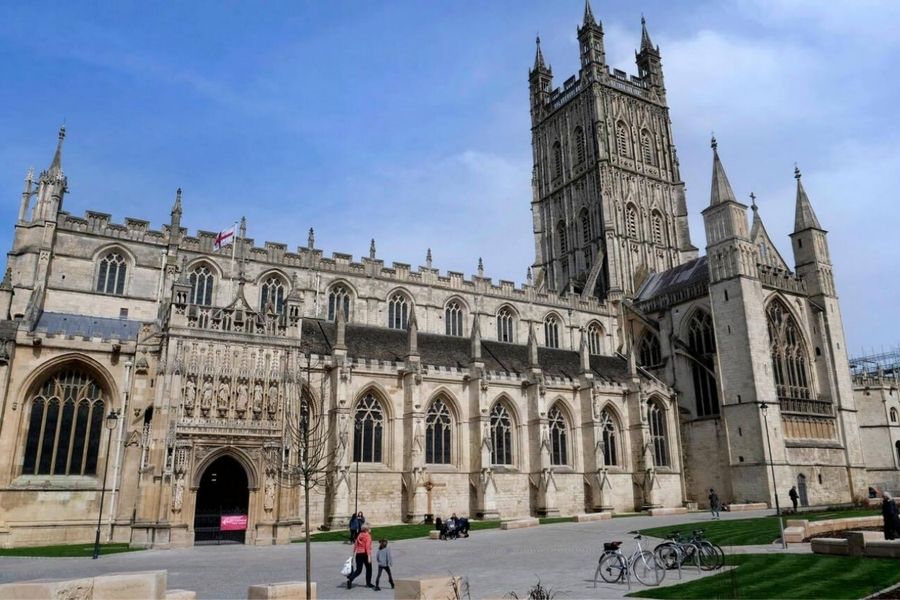
The transepts, where the main body meets the cross-shaped arms, blend old and new styles. I keep spotting medieval carvings, tombs, and stained glass throughout—there’s this constant dance between the Norman foundation and the more decorative Gothic touches.
Perpendicular Style and Fan-Vaulted Roof
The cloisters at Gloucester Cathedral show off England’s finest perpendicular Gothic architecture. Built in the late 1300s and early 1400s under Abbot Froucester, this part is famous for its fan-vaulted roof.
Standing beneath those intricate stone fans, I just had to pause and look up. Each rib fans out from slender columns, weaving a geometric pattern across the ceilings.
These fan vaults give the space a rhythm and grace that draws both visitors and filmmakers. The perpendicular style emphasizes vertical lines and huge window panels.
This look, perfected right here, changed how English cathedrals felt—a real turning point for medieval architecture.
Exploring the Whispering Cloisters
The cloisters at Gloucester Cathedral are a maze of arched passageways, each with its own stories and quirks. Alongside the stunning architecture, every corridor reveals something new.
The North Cloister and Its Mystique
The North Cloister feels different somehow, like it’s keeping secrets. Its fan-vaulted ceiling is honestly breathtaking, with elegant stone tracery that pulls your gaze upward.
As I moved through, the cool air and soft echoes gave the place a calm, slightly mysterious vibe. It’s easy to see why Harry Potter fans flock here.
Several scenes from the movies were filmed along the North Cloister, including those classic Hogwarts hallway moments. The corridor’s acoustics make it a real “whispering gallery”—I tried it, and a soft word at one end really does carry to the other.
Detailed medieval carvings line the walls. Benches built into the stone remind me of the monks who once read or just enjoyed the peace here.
South Cloister: Echoes of History
The South Cloister stands out for its role in daily monastic life. This wasn’t just a passageway—it was central to the abbey’s routines.
The stone floor is worn smooth from centuries of footsteps—monks, visitors, and now people like me. Walking here, I pictured the monks shuffling past in silence, heading for prayers or chores.
In the Harry Potter films, the South Cloister shows up as a Hogwarts hallway, easy to spot with its high, arched windows. Light filters through and creates a shifting mosaic of shadows and sunshine.
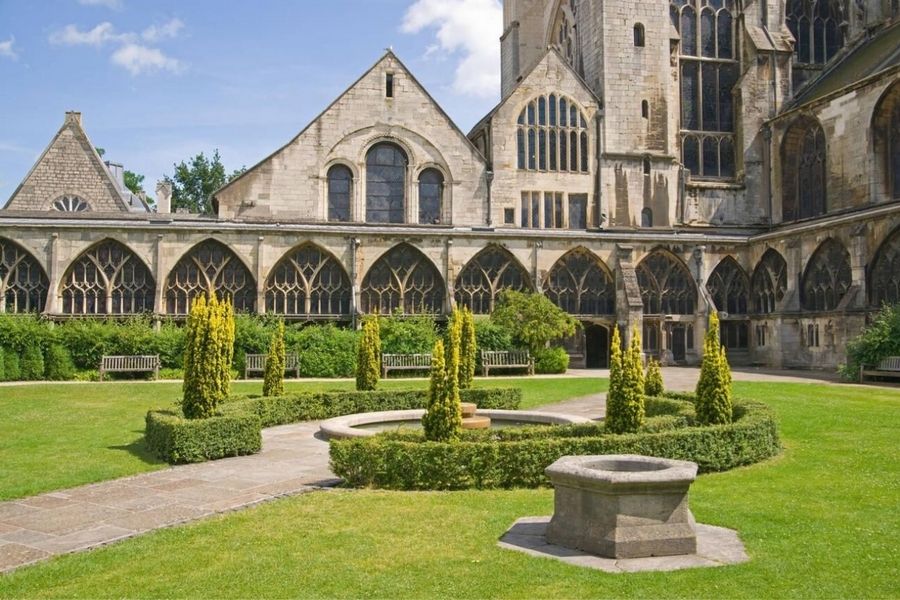
The South Cloister feels alive with echoes from the past.
East Cloister and Lavatorium
Turning into the East Cloister, I noticed it connects straight to the lavatorium. This wasn’t a bathroom, but a communal washing area for monks before meals and prayers.
The circular stone basin still sits here, along with traces of old water channels beneath the floor. The East Cloister feels quieter and more intimate, with views of the garden and the Chapter House’s base.
I stopped to admire the detailed stonework and the practical beauty of the lavatorium. It’s a reminder of how seriously the monks took hygiene and routine.
The East corridor even pops up in Harry Potter, most famously as the entrance to the Gryffindor Common Room. It’s a real blend of movie magic and medieval reality.
West Corridor and Unique Features
The West Corridor puts Gloucester Cathedral’s craftsmanship on full display. The fan vaulting here is especially bold, with each rib and boss carefully carved.
Late afternoon sunlight slips in from the cloister garth, making the stones glow. One highlight is the sturdy wooden door that shows up in film and TV, including the Harry Potter series.
Walking this corridor, I retraced the steps of filmmakers and monks. Memorial tablets, inscriptions, and original doorways line the walls, some leading to old storage rooms.
This mix of history and film makes the West Corridor a place where centuries seem to overlap.
Harry Potter at Gloucester Cathedral: A Magical Legacy
Gloucester Cathedral played a starring role in several key Harry Potter scenes set inside Hogwarts. The cloisters, doors, and corridors brought the stories to life for both cast and fans, turning this ancient church into a must-see for Potter lovers.
Iconic Harry Potter Filming Locations
As soon as I entered the cloisters, I recognized them from the films. Each corridor—North, South, East, and West—helped create that magical Hogwarts vibe.
The stone archways and echoing halls just nail the mysterious feel of the wizarding school. Some standout filming spots include:
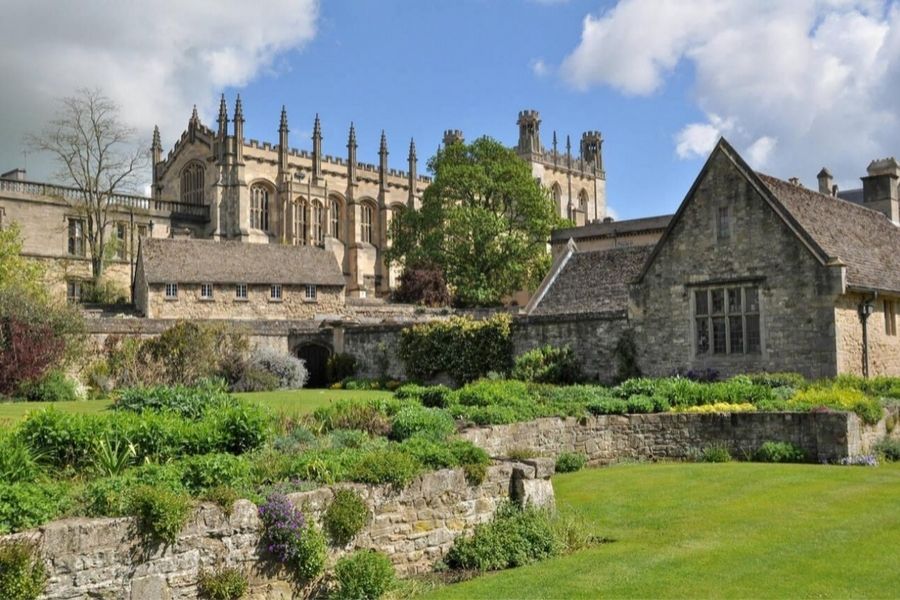
- The wooden door on the East Corridor, which became the entrance to the Gryffindor common room (with the Fat Lady’s portrait imagined above).
- The South Corridor, one of the first Hogwarts interiors you see on screen, where students arrive for the first time.
- The corridor lined with windows, popping up again and again as students hurry between classes.
These areas aren’t blocked off, so I got to explore where the scenes actually happened. The real-world space and architecture bring extra weight to those magical movie moments.
Memorable Scenes: Philosopher’s Stone to Half-Blood Prince
Gloucester Cathedral appears in three Harry Potter films: Philosopher’s Stone (2001), Chamber of Secrets (2002), and Half-Blood Prince (2009). Loads of memorable scenes were filmed here, from everyday Hogwarts life to big story moments.
In Philosopher’s Stone, I recognized the south corridor when Harry and the other first years are led by Percy Weasley to Gryffindor Tower. In Chamber of Secrets, the same corridor is covered in a giant spider web, just after Mrs. Norris is found petrified.
During Half-Blood Prince, the cloisters show up again in a tense scene with Snape and Narcissa Malfoy making the Unbreakable Vow. The echoing hallways ramp up the suspense, even without any digital effects.
Each time I visit, I remember lines and scenes—like the whispers about Moaning Myrtle—filmed right where I’m standing.
Reliving Hogwarts: Common Rooms and Corridors
Tracing the path to the Gryffindor common room is a highlight at Gloucester Cathedral. The wooden door in the East Cloister stands just as it did in the movies, with the Fat Lady’s frame imagined above.
Walking these corridors, it genuinely feels like stepping onto the Hogwarts set. The stone floors, carved archways, and aging walls look unchanged from the films.
I could almost see Harry and Ron rushing past, books in hand, while Muggles like me try to blend in. For fans, the cloisters are a rare chance to experience Hogwarts with no screen in the way.
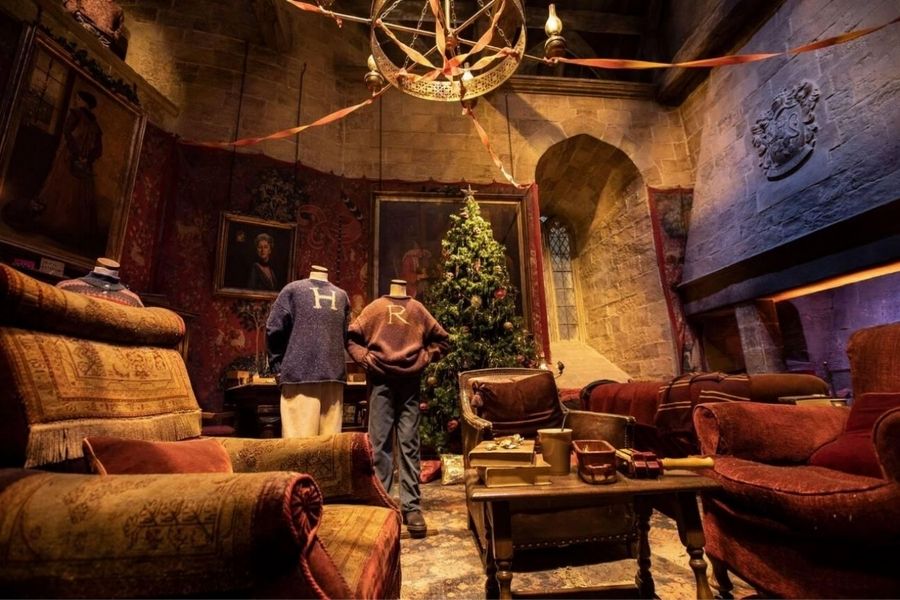
It’s easy to picture the Quidditch team jogging by or hear the latest gossip about the Chamber of Secrets echoing down the hall.
Behind the Scenes Trivia
Filming at Gloucester Cathedral came with plenty of challenges for the cast and crew. To protect the building, they had to cover the ancient floors and hide modern features like radiators.
Some set pieces, like portraits, were just temporary. Here’s a quick look at some fun facts:
| Fact | Detail |
|---|---|
| Films shot at the Cathedral | Philosopher’s Stone, Chamber of Secrets, Half-Blood Prince |
| Key filming areas | North, South, East, and West Cloister Corridors |
| Filming challenges | Preserving the historic site, hiding modern features like radiators |
| Unique set dressing | Fake spider webs, removable wall paintings |
| Memorable off-screen moments | Cast members signing the visitor book, locals acting as extras |
I learned that not all Hogwarts interiors were filmed here, but the look of Gloucester Cathedral still shapes how I picture Hogwarts in my mind.
Treasures of Art, Worship, and Music
Gloucester Cathedral is packed with stunning art and moments of reflection. Its spaces invite you to pause, listen, and take in traditions that have lasted for centuries.
Stained Glass Windows and the Great East Window
The stained glass windows immediately caught my eye. They fill the cathedral with colored light, turning the stone into something alive.
The Great East Window is one of the biggest medieval stained glass windows in England. Finished in the 1350s, it’s almost as big as a tennis court.

Its scenes show stories from both the Old and New Testament, along with English kings and bishops. I found myself drawn to the details—faces of saints, scenes of everyday life from centuries ago.
If you visit, don’t miss this window. It’s worth lingering over.
The Choir and Musical Heritage
Music gives Gloucester Cathedral much of its special atmosphere. The choir has sung here for centuries, and today, boys and girls join adults for services and concerts.
The cathedral’s organ is legendary. People travel from all over to hear it, especially during the annual Three Choirs Festival. This event rotates between three historic cathedrals and is one of the world’s oldest music festivals.
I loved how music connects past and present here. Voices echo through the cloisters and nave, adding emotion to every service and drawing you into the experience.
Moments of Worship and Community
Gloucester Cathedral isn’t just a place to admire—it’s alive with people coming for daily worship, special services, or simply a quiet moment.
During my visit, I saw people lighting candles and pausing in silent reflection. The cathedral holds regular services for everyone, locals and tourists alike.
Events for families, school groups, and people of all faiths make the place feel welcoming. That sense of community is hard to miss.
Worship here ties generations together. The traditions kept by clergy, choir, and visitors show how faith is both personal and shared in this ancient space.
Gloucester Cathedral in History, Culture, and Screen
Gloucester Cathedral stands out for its long story, royal connections, famous films, and unusual traditions. Honestly, I didn’t expect to find so much history and culture packed into one place—from medieval games to scenes straight out of modern TV.
From Abbey to Icon: Key Events and Figures
Back around 678 AD, Osric, King of the Hwicce, founded what would become Gloucester Cathedral. They first dedicated it to Saint Peter and called it St Peter’s Abbey, and that name stuck until Henry VIII’s Dissolution of the Monasteries in 1541 turned it into a cathedral.
Generations of leaders and monks kept expanding and rebuilding the place. The building itself is a bit of a mashup: Norman Romanesque meets Perpendicular Gothic. Those soaring windows and fan-vaulted cloisters? They’re striking and have seen their share of centuries. You can really feel the ups and downs of English religious and political life just by wandering through.

The Great East Window, finished in the 1350s, was once the largest stained glass window anywhere. Artists and architects have drawn inspiration from it for ages. When I wandered its halls, I picked up on echoes of quiet monastic days and big, history-making moments.
Famous Burials: Edward II and Beyond
King Edward II lies buried here. After his mysterious end at Berkeley Castle in 1327, they brought him to Gloucester, and his tomb quickly became a magnet for pilgrims.
Edward II’s presence brought fresh attention and funds to the abbey. They poured money into new stonework and decorations, and his shrine still stands out—bright, detailed, and full of scenes from his reign.
You’ll also find the tomb of Robert Curthose, the eldest son of William the Conqueror, tucked away in the choir. There’s a real mix of royal and clerical graves, giving the whole place a deep connection to England’s story.
Cultural Impact: TV, Films, and Documentaries
Gloucester Cathedral’s cloisters have starred in more than a few big films and TV shows. The medieval corridors doubled as Hogwarts in the first two Harry Potter movies—and even popped up again in the sixth. Walking through, I almost expected to see a ghost or two.
The cathedral has also shown up in Doctor Who, Wolf Hall, and Sherlock. Its dramatic setting keeps drawing filmmakers and history buffs. Once, I stumbled into a behind-the-scenes display from a film shoot, and I’ve even seen documentary crews at work in the nave.
They host exhibitions and events that celebrate the cathedral’s screen life. Library tours sometimes share stories about the treasures that inspired writers. It’s not unusual to bump into fans from all over, hoping to soak up a bit of that movie magic.
Medieval Football, Conservation, and Legacy
Believe it or not, people once played wild medieval football matches right on cathedral grounds. These stitched-ball games drew big crowds and sometimes sparked local arguments. It’s a reminder that the cathedral has always been woven into city life, not just a quiet place for prayers.
Conservation here never really stops. Teams of experts tackle stonework, windows, and ancient beams, blending old-school craftsmanship with new tech. I toured the library and saw how they work to protect rare manuscripts and centuries-old books.
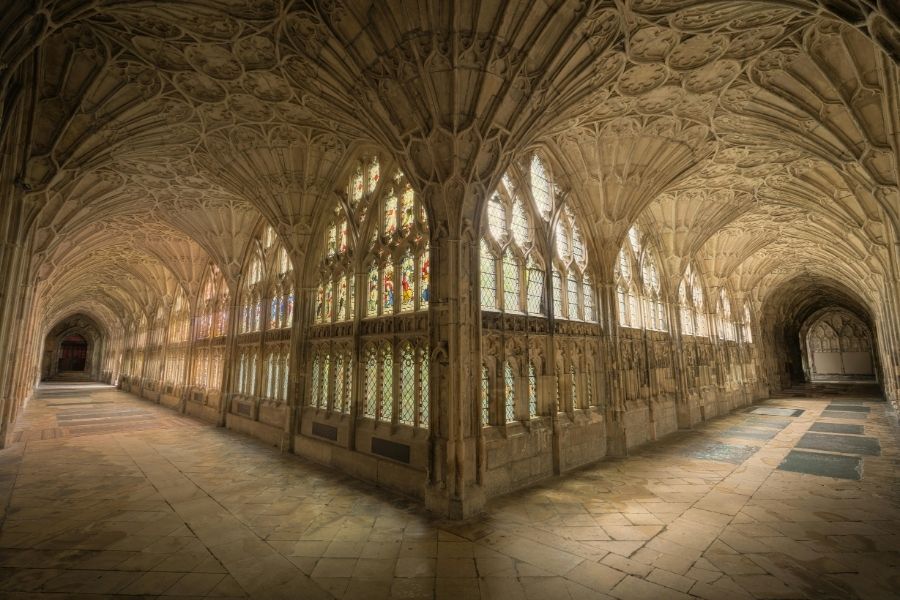
The cathedral’s legacy is a mix of worship, heritage events, and community outreach. Somehow, it keeps finding new ways to matter—balancing its ancient roots with all the challenges of the present.
Visiting Gloucester Cathedral and Surroundings
When I visited Gloucester Cathedral, I found way more than just stunning architecture. There’s a lot to explore nearby, and Gloucestershire itself turned out to be full of surprises.
Guided Tours and Exhibitions
I kicked things off with a guided tour of Gloucester Cathedral. The guides really know their stuff and brought the stories of the old monks to life, even pointing out the famous fan-vaulted ceilings where “Harry Potter” scenes were filmed.
Climbing the tower was a highlight. The view from the top stretches out over the city and those rolling hills—definitely worth the effort.
Throughout the year, the cathedral hosts different exhibitions. Some focus on art or stained glass, others on local history. The interactive displays actually made learning fun. I noticed that both kids and adults got caught up in the stories of Edward II’s tomb and the medieval crypt.
Exploring Gloucester and the Cotswolds
After I finished at the cathedral, I wandered down to Gloucester Docks. It’s lively, with cafes, museums, and shops lining the old canals. The place buzzes with activity but still keeps that old-world charm.
The National Waterways Museum stands out if you’re curious about local trade or river history. It’s not huge, but I found it surprisingly engaging.
Gloucester makes a great base for exploring the Cotswolds. Those stone villages and the countryside feel almost unreal. The M5 motorway makes it easy to reach places like Bourton-on-the-Water or Stow-on-the-Wold by car.
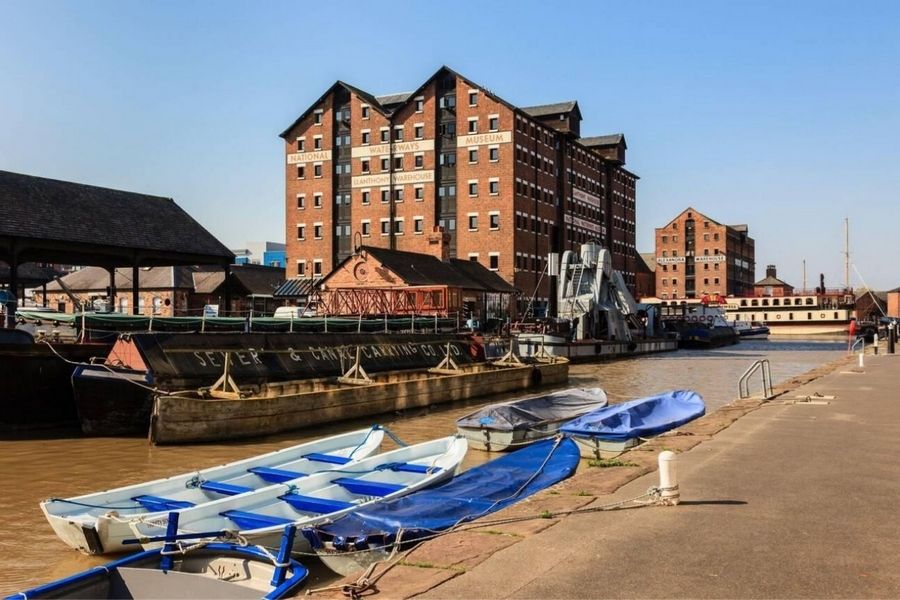
Nature fans should check out the Forest of Dean, just a short drive west. You’ll find forest walks and plenty of outdoor activities, no matter your age.
Day Trips: Lacock Abbey, Durham Cathedral, and More
If you’ve got time for day trips, there are some gems nearby. Lacock Abbey is about an hour’s drive south and it’s another Harry Potter filming spot. The cloisters and rooms will look familiar to fans, and the village itself feels frozen in time.
For a longer adventure, I hopped on a train north to Durham Cathedral. It’s a bit of a trek—over three hours—but the trip is pretty easy to sort out. Durham’s massive Norman cathedral and its riverside views really leave an impression.
Each of these spots brought a fresh angle to English history and architecture. If you’re up for a little travel, you won’t run out of things to see.
Practical Visitor Information
Opening Times: Gloucester Cathedral opens most days, though sometimes events or services change the schedule. It’s always a good idea to double-check before you go.
Admission: You can usually visit with just a donation, which feels refreshingly low-pressure. If you want to join something special—like the tower tour—there’s an extra fee.
Getting There: Driving in? The M5 gets you to Gloucester from most big cities without much hassle. I found parking close by, but public transport works too; local buses and trains run regularly.

Facilities: Inside, you’ll spot a cozy café, clean restrooms, and a shop packed with books and souvenirs. The staff seemed genuinely happy to chat or help out. When I walked in, I grabbed a city map and a few tour leaflets right at the entrance—super handy if you’re planning to wander around after.

